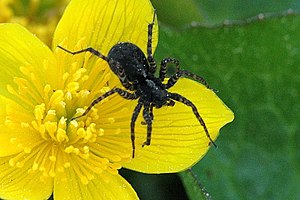Garden wolf spider
| Garden wolf spider | ||||||||||||
|---|---|---|---|---|---|---|---|---|---|---|---|---|

Garden wolf spider ( Pardosa hortensis ), female |
||||||||||||
| Systematics | ||||||||||||
|
||||||||||||
| Scientific name | ||||||||||||
| Pardosa hortensis | ||||||||||||
| ( Thorell , 1872) |
The garden or vineyard wolf spider ( Pardosa hortensis ) is a web spider from the family of wolf spiders (Lycosidae). Contrary to what its first common name suggests, it is rarely found in gardens.
features
The female of the garden wolf spider reaches a body length of 4.5 to six and the male one of 3.5 to 4.5 millimeters. Like all species of the genus, the garden wolf spider is one of the smaller wolf spider species. The species has a gray-brown or, more rarely, dark brown basic color. As with the other species of the genus Pardosa , the garden wolf spider also has a lighter longitudinal band in the center of the prosoma . This is darker at the front of the garden wolf spider and also widened there. There are also side ligaments in this species, but they are indistinct and interrupted in places. The sternum is dark brown in color and sometimes a little lighter in the center. The opisthosoma is covered with fine hairs that form a light heart mark in front and a double row of dark spots in the back. However, this is less clear in the male, as the hairs are denser in the front area and fused with the heart mark and less dense in the rear area. The legs are light brown and have different numbers of dark brown stripes depending on gender. In females, the ringlets occur in the femur , tibia and metatarsi area . In the male, only the femur are curled.
Similar species
The garden wolf spider sometimes resembles other species of the genus, especially the dark wolf spider ( P. amentata ). However, the garden wolf spider is a little lighter than this.
Occurrence
The garden wolf spider is distributed from Europe with the main distribution in southern Europe ( it is not common in Central and Eastern Europe and Great Britain ) over large parts of Asia , including Turkey , the Caucasus , Iran , Russia (to southern Siberia ) and Japan . In Germany it mainly populates the low mountain range and is practically absent in the north German lowlands, in the east and south-east of Germany. As a heat-loving species, it lives in poor grasslands , semi-arid and dry grasslands , vineyards , dwarf shrub heaths and dry ruderal areas and prefers these over gardens . The garden wolf spider can be found up to a height of 1,500 meters.
Threat and protection
The garden wolf spider can often be found in suitable locations and especially in southern Europe. In Germany, the species predominantly inhabits the low mountain ranges . Further north, the garden wolf spider becomes rarer or does not appear at all. The species is not rated by the IUCN .
Way of life
Like almost all wolf spiders, the garden wolf spider also hunts freely or as a stalker and without a safety net. Other arthropods of suitable size are preferred as prey .
Reproduction

As with all wolf spiders, after mating, the female attaches her made egg cocoon to her spinnerets and carries it around with her. In the same way, the hatched young stay on the mother's opisthosoma and remain there for about a week before they become independent and grow up. Adult specimens of the garden wolf spider can be found all year round, but preferably from the end of March to October.
Systematics
Like many wolf spiders, the garden wolf spider was renamed several times. First describer Tord Tamerlan Teodor Thorell called the species Lycosa hortensis in 1872 . The species was first given its current name under Eugène Simon in 1876. Since Jacobus Theodorus Wiebes used this species name again in 1959, it has been used exclusively for the garden wolf spider.
gallery
Individual evidence
- ↑ a b c d e f g h i Description of the garden wolf spider at www.natur-in-nrw.de ( Link ), accessed on December 13, 2019.
- ↑ a b c d e Pardosa hortensis in W. Nentwig, T. Blick, D. Gloor, A. Hänggi, C. Kropf: Spinnen Europa . http://www.araneae.unibe.ch Version 07.2016, accessed on December 13, 2019.
- ↑ a b Pardosa hortensis (Thorell, 1872) in the WSC World Spider Catalog , accessed December 13, 2019.
- ↑ a b Pardosa hortensis (Thorell, 1872) at Global Biodiversity Information Facility , accessed on December 13, 2019.
Web links
- Pardosa hortensis in the World Spider Catalog
- Garden wolf spider on http://www.natur-in-nrw.de accessed on December 13, 2019.
- Pardosa hortensis in W. Nentwig, T. Blick, D. Gloor, A. Hänggi, C. Kropf: Spinnen Europa . http://www.araneae.unibe.ch Version 07.2016, accessed on December 13, 2019.
- Pardosa hortensis (Thorell, 1872) in the WSC World Spider Catalog , accessed December 13, 2019.
- Pardosa hortensis (Thorell, 1872) from Global Biodiversity Information Facility , accessed December 13, 2019.

